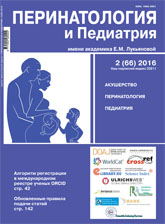Перинатальная диагностика гастрошизиса у плодов и новорожденных детей
DOI:
https://doi.org/10.15574/PP.2016.66.70Ключевые слова:
новорожденные дети, гастрошизис, пренатальная диагностика, постнатальная диагностикаАннотация
Цель — разработать и усовершенствовать характер и объем пренатальной и ранней постнатальной диагностики гастрошизиса у плодов и новорожденных детей.
Пациенты и методы. В ГУ «Институт педиатрии, акушерства и гинекологии НАМН Украины» за 2006–2015 гг. пренатально обследованы 43 плода с гастрошизисом. Во время пренатального обследования плода с гастрошизисом, кроме специалистов УЗИ, обязательно присутствовал детский хирург.
Результаты. У 100% прооперированных новорожденных детей с гастрошизисом диагноз установлен пренатально. Частота ранней пренатальной диагностики гастрошизиса (до 22 недель гестации) — 43,6%, что требует дальнейшего усовершенствования.
Выводы. Основными критериями пренатальной диагностики гастрошизиса у плода являются: локализация и величина сквозного дефекта передней брюшной стенки, характер эвентрированных органов, их состояние и объем; объем брюшной полости и степень висцероабдоминальной диспропорции; выявление ассоциируемых пороков развития и заболеваний; количество околоплодных вод; цитогенетическое исследование с определением кариотипа плода. Алгоритм постнатальной диагностики гастрошизиса и ассоциируемых пороков развития и заболеваний у новорожденных включает: УЗИ органов брюшной полости и внебрюшного пространства; эхокардиографию и нейросонографию; обзорную рентгенографию органов грудной клетки и брюшной полости, пассаж контраста по желудочно-кишечному тракту, ирригографию — при подозрении на кишечную непроходимость; консультацию невролога, а при необходимости — и других специалистов.
Библиографические ссылки
Bisaliev BN. 2011. Optimizatsiya lecheniya gastroshizisa. Dis. k.med.n. Moskva: 120.
Plohih DA. 2007. Hirurgicheskoe lechenie gastroshizisa s vistsero-abdominalnoy disproportsiey. Dis. k.med.n. Kemerovo: 22.
Slyepov OК, Hrasyukova NІ, Soroka VP, Ponomarenko OP. 2014. The comparative characteristic of an anatomical features and condition of the eventrated organs at gastroschisis among naturally born babies and by cesarean section. Perinatologiya i pediatriya. 3(59): 16—20.
Tarapurova OM, GordIEnko IYu, NIkItchina TV ta In. 2006. Prenatalna dIagnostika ta vedennya vagItnostI pri vrodzhenih vadah rozvitku perednoYi cherevnoYi stInki u ploda. Ultrazvukova perinatalna dIagnostika. 2: 59—71.
Sliepov OK, Veselskyi VL, Hrasiukova NI. 2014. Chastota i prychyny smertnosti novonarodzhenykh ditei iz hastroshyzysom. Khirurhiia dytiachoho viku. 3(4): 81—87.
Gibbin C, Tonch S, Broth RE et al. 2003. Abdominal wall defects and congenital heart disease. Ultrasound Obstet. Gynecol. 21: 334—337. http://dx.doi.org/10.1002/uog.93; PMid:12704739
Bianchi A, Dickson A. 1998. Elective delayed reduction and no anesthesia: minimal intervention management for gastroschisis. J Pediatr Surg. 53; 9: 1338—1340. http://dx.doi.org/10.1016/S0022-3468(98)90002-1
Cedergen M, Selbing A. 2006. Detection of fetal structural abnormalities by an 11 — 14 week ultrasound dating scan in an unselected Swedish population. Acta Obstet Gynecol Scand. 85: 912—915. http://dx.doi.org/10.1080/00016340500448438; PMid:16862467
Chabra S. 2006. Management of gastroschisis: prenatal, perinatal and neonatal. Neoreviews. 7: 419—427.
">http://dx.doi.org/10.1542/neo.7-8-e419
David AL, Tan A, Curry J. 2008. Gastroschisis: conographic diagnosis, associations, management and outcome. Prenatal Diagn. 29: 633—644. http://dx.doi.org/10.1002/pd.1999; PMid:18551719
Murphy FL, Mazlan JA, Jarheen F et al. 2007. Gastroschisis and exomphalos in Ireland 1998—2004. Does antenatal diagnosis impact on ontcome? Pediatr Surg Int. 23: 1059—1063. http://dx.doi.org/10.1007/s00383-007-2001-z; PMid:17701414
Feldkamp ML, Carey JC, Sadler TW. 2007. Development of gastroschisis: review of hypotheses, novel hypothesis, and implications for research. Am J Med Genet. 143A: 639—652. http://dx.doi.org/10.1002/ajmg.a.31578; PMid:17230493
Holland AJA, Walker K, Badanti N. 2010. Gastroschisis an update. Pediatr Surg Int. 26: 871-878. http://dx.doi.org/10.1007/s00383-010-2679-1; PMid:20686898
Kazanra M, Sic R, Irgens S et al. 2004. Increasing risk of gastroschisis in Norway: an age-period-cohort analysis. Am J Epidemiol. 159; 4: 358—363. http://dx.doi.org/10.1093/aje/kwh051
Islam S. 2008. Clinical care outcomes in abdominal wall defects. Curr Opin Pediatr. 20: 305—310. http://dx.doi.org/10.1097/MOP.0b013e3282ffdc1e; PMid:18475100
Kohl T, Tchatcheva K, Stressig R et al. 2009. Is there a therapeutic role for fetoscopic surgery in the prenatal treatment of gastroschisis? A feasibility study in sheep. Surg Endosc. 23: 1499—1505. http://dx.doi.org/10.1007/s00464-009-0394-6; PMid:19263117
Joane M, Dolk H, Bradbury I. 2007. Increasing prevalence of gastroschisis in Europe 1980—2002: a phenomen restricted to younger mothers? Paediatr Perinat Epidemiol. 21: 363—369. http://dx.doi.org/10.1111/j.1365-3016.2007.00820.x; PMid:17564594
Joo JG, Csatlos E, Rigo JJz. 2010. Abdominal wall malformations in a 15 — year fetopatological study: accuracy of prenatal ultrasonography diagnosis. Prenat Diagn. 30: 1015—1018. http://dx.doi.org/10.1002/pd.2515; PMid:20925045
Kronfli R, Bradnock TJ, Sabharwal A. 2010. Intestinal atresia in association with gastroschisis: a 26 — year review. Pediatr Surg Int. 26: 891—894. http://dx.doi.org/10.1007/s00383-010-2676-4; PMid:20676892
Nicholas S, Tunli MG, Dicke J et al. 2010. Estimation of fetal weight in fetuses with abdominal wall defects comparison of 2 recent sonographic formulas to formula. J Ultrasound Med. 29: 1069—1074. PMid:20587430
Lao OB, Larison C, Garrison MM et al. 2010. Outcomes in neonates with gastroschisis in U. S. children's hospitals. Am J Perinatal. 27: 97—101. http://dx.doi.org/10.1055/s-0029-1241729; PMid:19866404 PMCid:PMC2854024
D'Antonio, Virgone C, Rizzo G et al. 2015. Prenatal risk factors and outcomes in gastroschisis: a meta-analysis. Pediatrics. 136: 159—169. http://dx.doi.org/10.1542/peds.2015-0017; PMid:26122809
Reid K, Dickinson J, Donerty D. 2003. The epidemiologic incidents of congenital gastroschisis in Western Australia. Am J Obstet Gynecol. 189; 3: 764—768. http://dx.doi.org/10.1067/S0002-9378(03)00819-6
Davis RP, Treadwell MC, Drongowski RA et al. 2009. Risk stratification in gastroschisis: can prenatal evaluation or early postnatal factors predict outcome? Pediatr Surg Int. 25: 319—325. http://dx.doi.org/10.1007/s00383-009-2342-x; PMid:19277683
Cohen-Overbeck TE, Hartmann TR, Stugers EA et al. 2008. The outcome of gastroschisis after a prenatal diagnosis or a diagnosis only at birth. Recommendations for prenatal surveillance. Eur J Obstet Gynecol Reprod Biol. 139: 21—27. http://dx.doi.org/10.1016/j.ejogrb.2007.10.008; PMid:18068889
Towers CV, Carr MN. 2008. Antenatal fetal surveillance in pregnancies complicated by fetal gastroschisis. Am J Obstet Gynecol. 198: 686—695. http://dx.doi.org/10.1016/j.ajog.2008.03.024; PMid:18538153
Sadler TW. 2010. The embryologic origin of ventral body wall defects. Semin Pediatr Surg. 19: 209—214. http://dx.doi.org/10.1053/j.sempedsurg.2010.03.006; PMid:20610194
Sekabira J, Hadley GP. 2009. Gastroschisis: a third world perspective. Pediatr Surg Int. 25: 327—329. http://dx.doi.org/10.1007/s00383-009-2348-4; PMid:19288118
Wilson RD, Johnson MP. 2004. Congenital abdominal wall defects: an update. Fetal Diagnos Ther. 19: 385—398. http://dx.doi.org/10.1159/000078990; PMid:15305094

